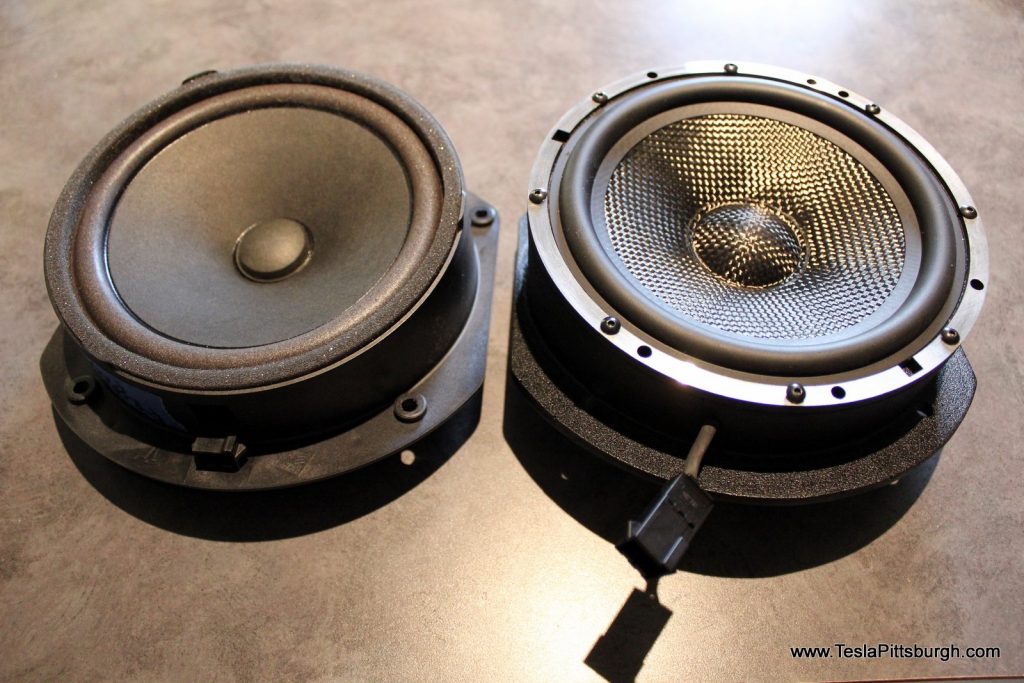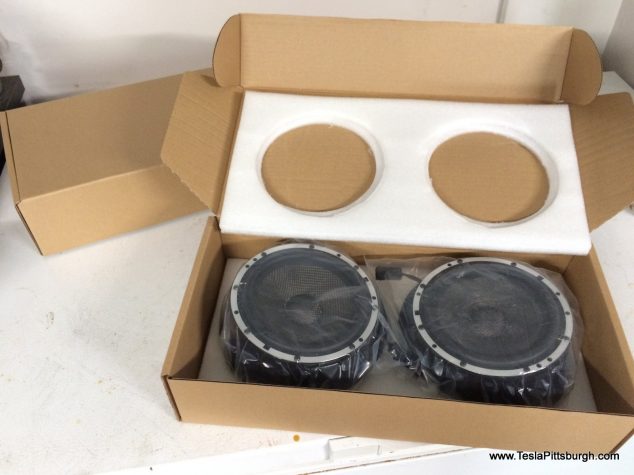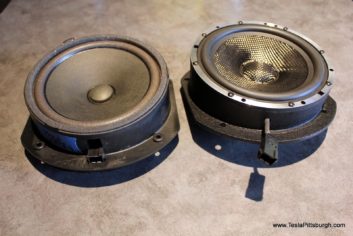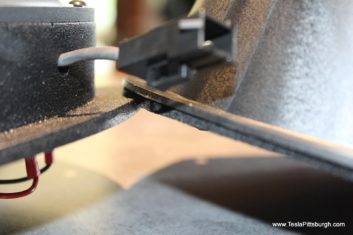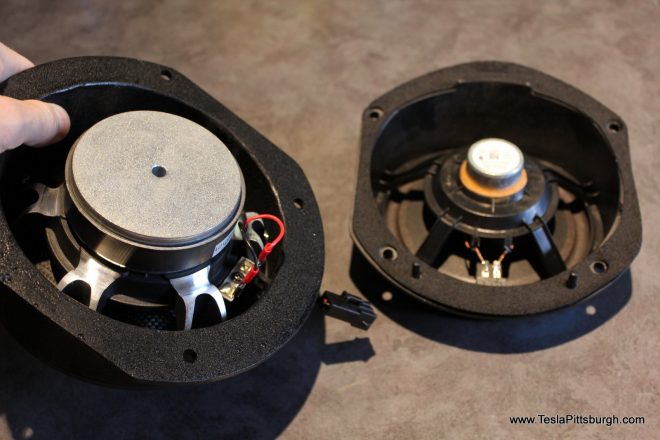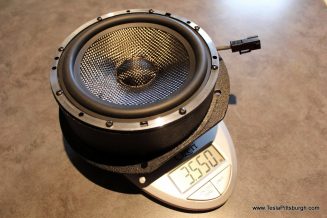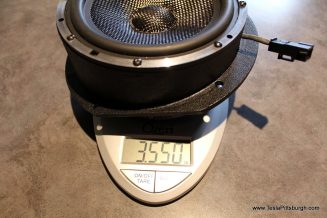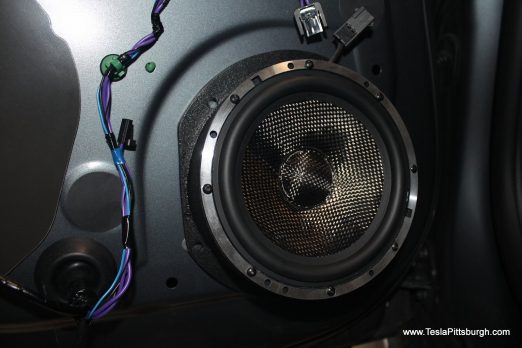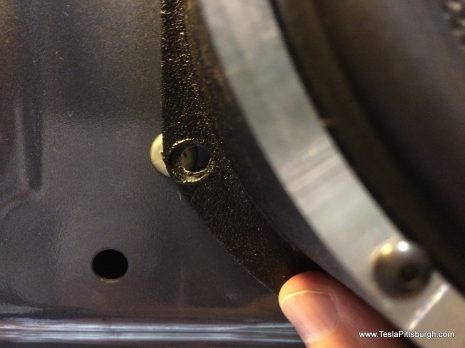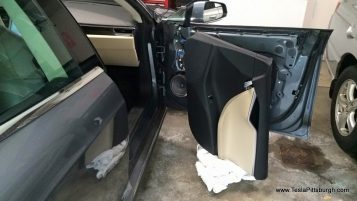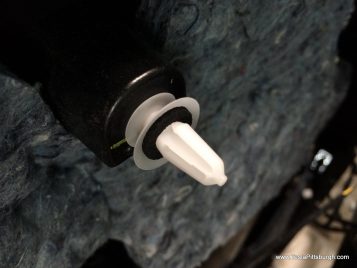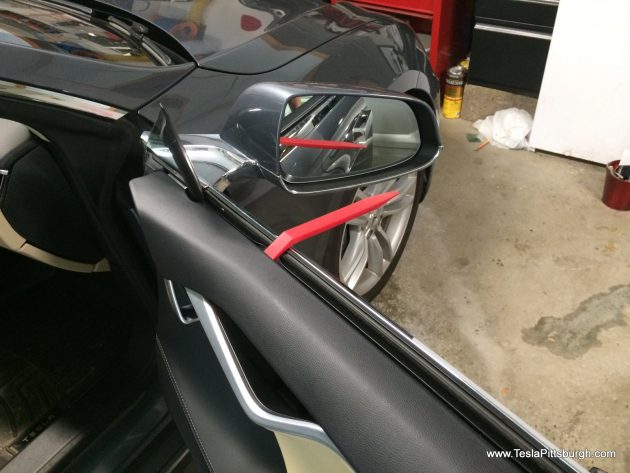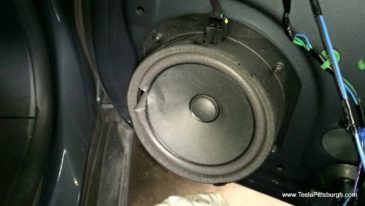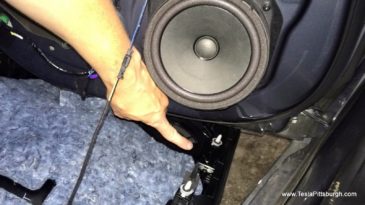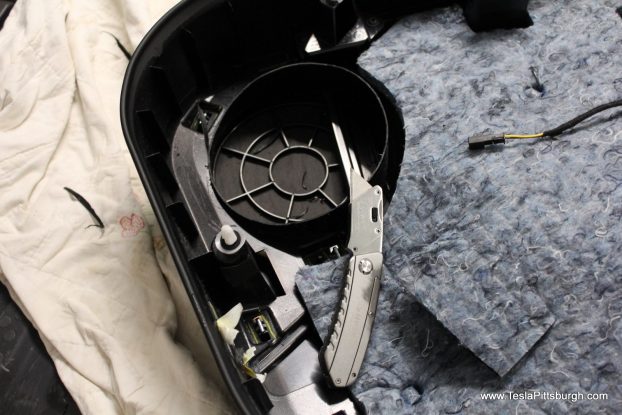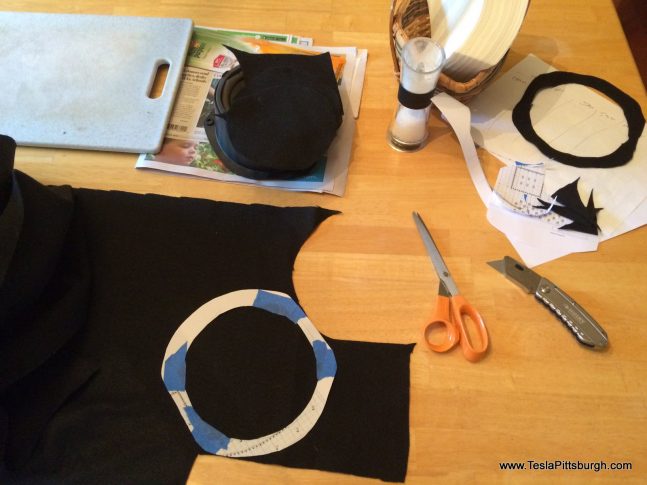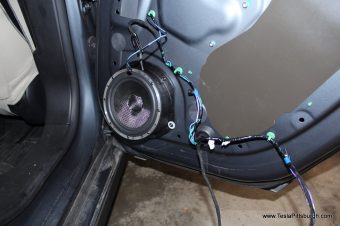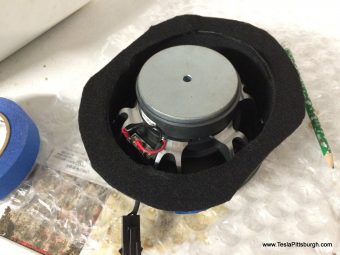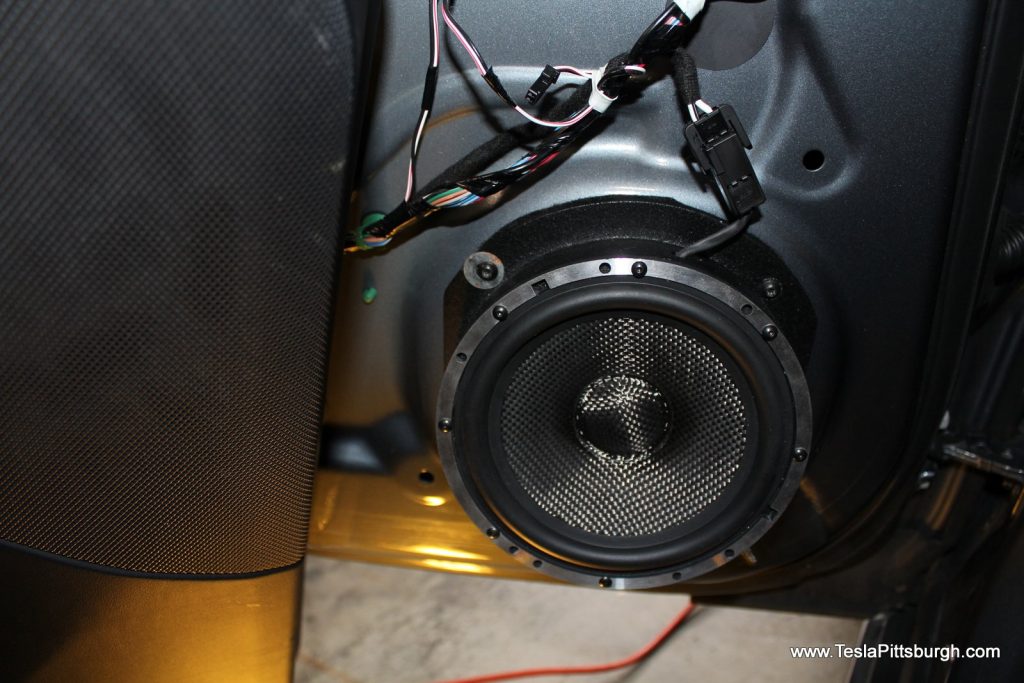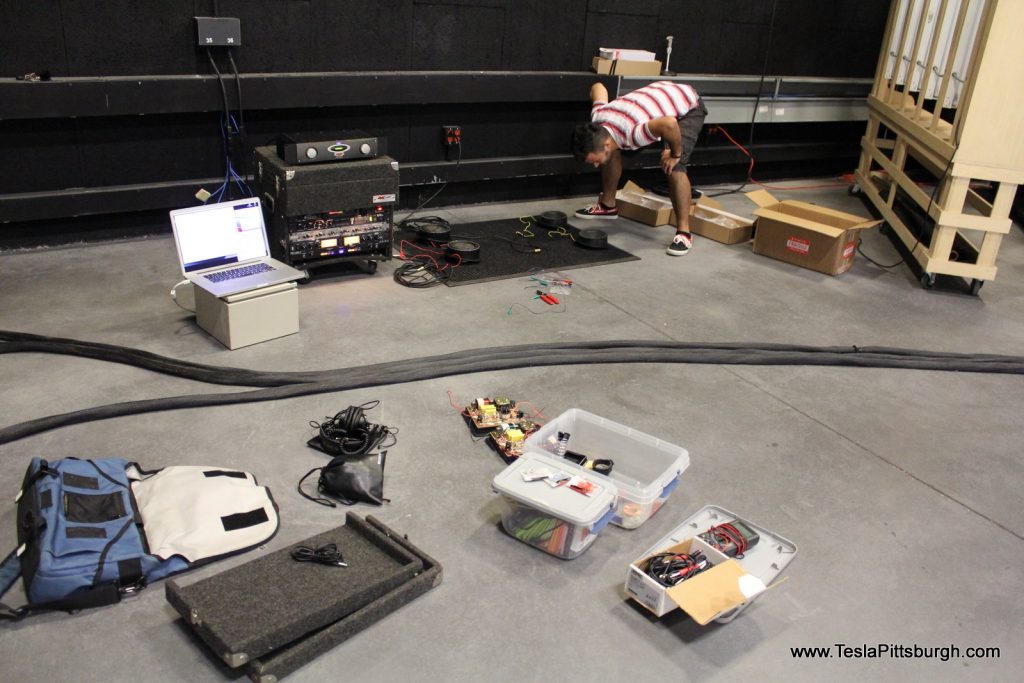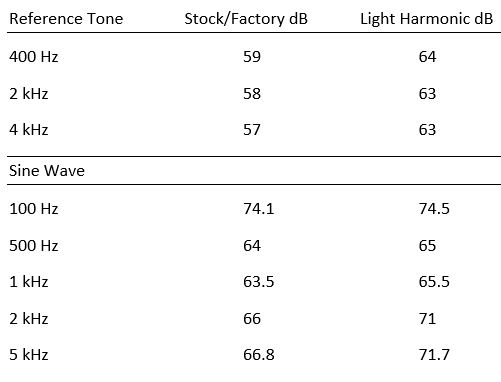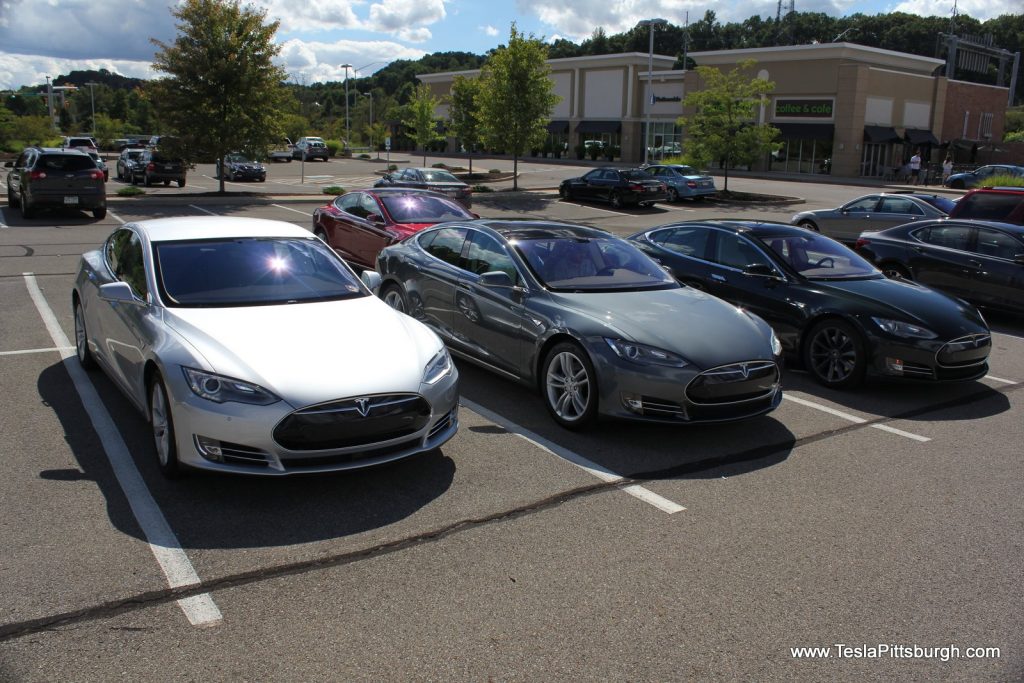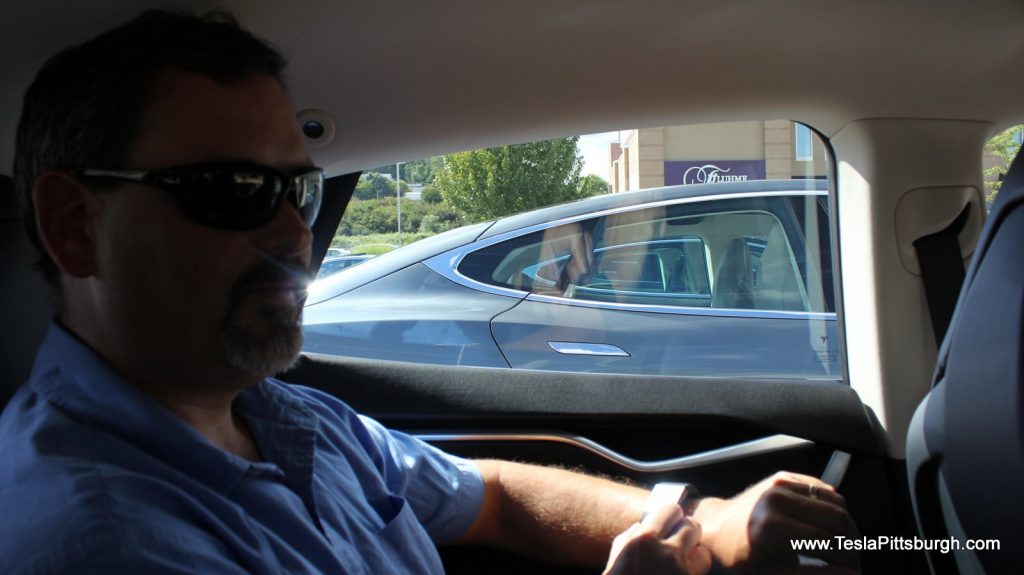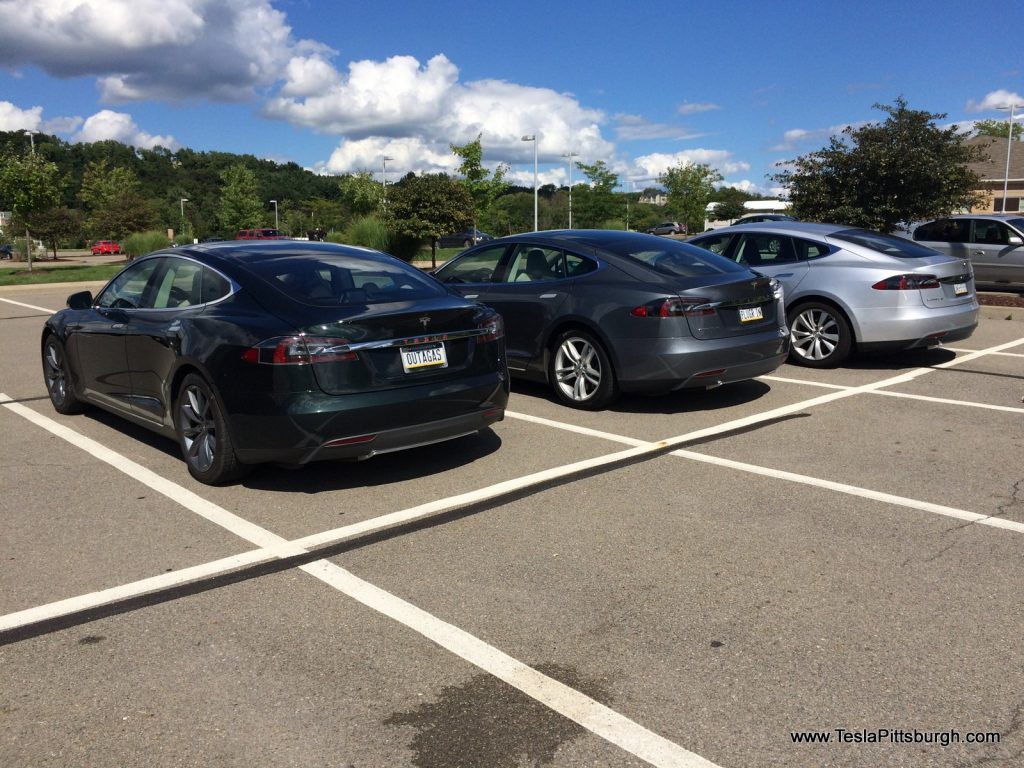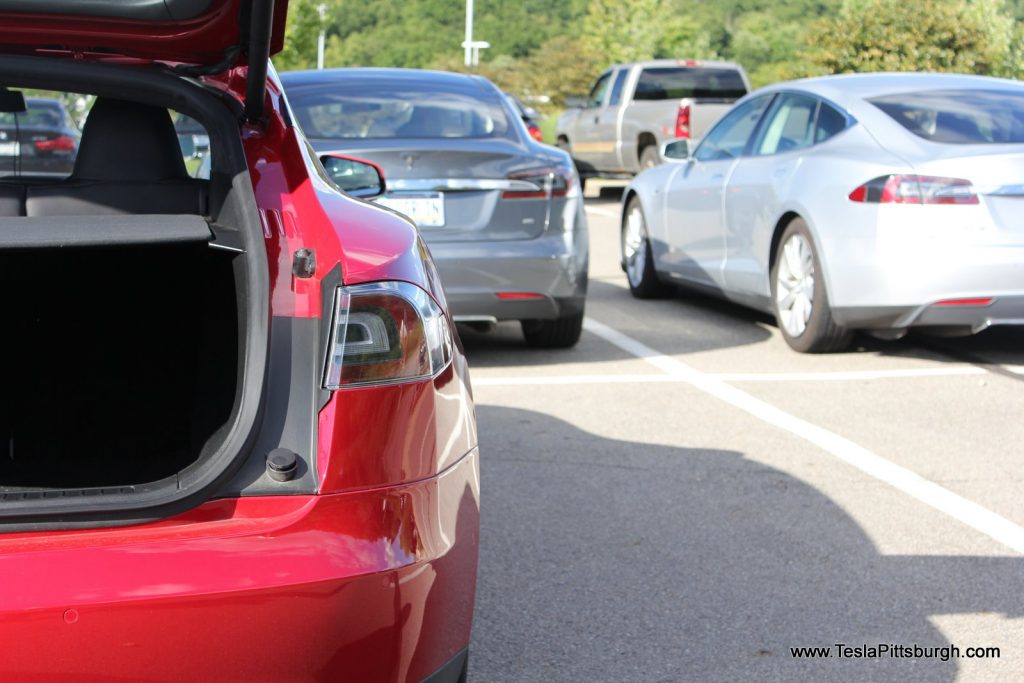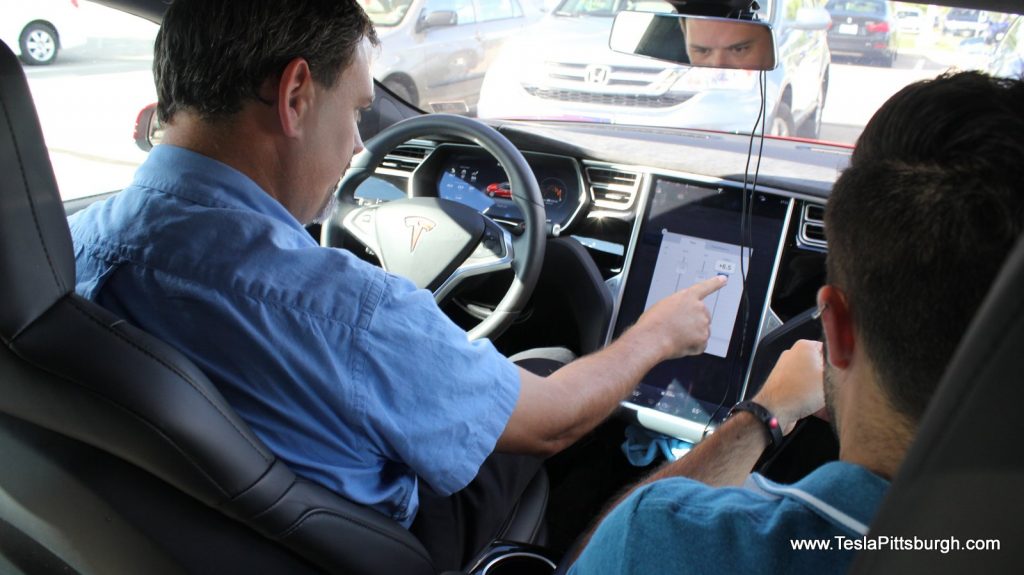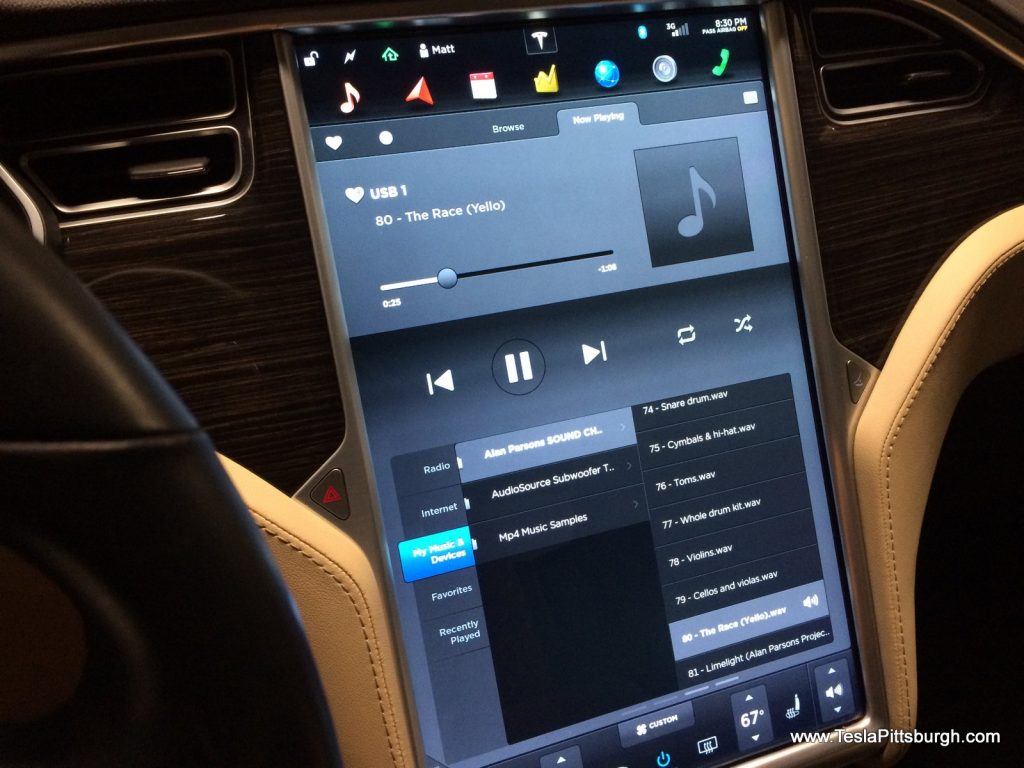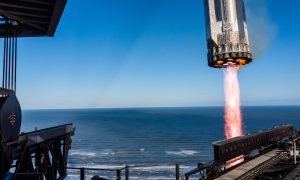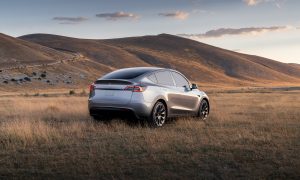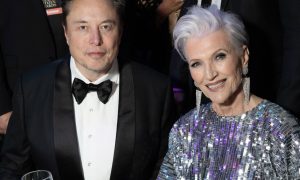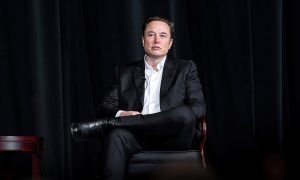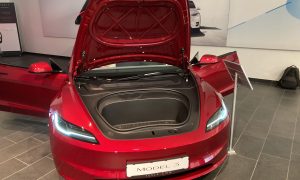If it’s true that “a picture is worth a thousand words,” then look at those two speakers. Can you see the difference? Alrighty then, that’s pretty much my review.
Let’s get this out of the way early: I am not an audio expert or engineer. But before you click away, let me assure you I’ve assembled a very qualified team and we’re going look into this subjective minefield of Tesla audio and see if I can’t persuade you to hear with my written words. If that doesn’t work, there’s also a video:
SURVEYING THE SOUNDSCAPE
Deciding which audio system to configure your Model S with is among the most ponderously debated discussions online and I’d bet a lucrative line item on Tesla’s post-order confirmation change fee reports. The consensus is generally that if you care about audio quality — or even THINK you might — then go ahead and drop another $2500 into Elon’s coffers for the Ultra-High-Fidelity Sound (UHFS). After all, the reasoning typically goes, you’re already spending so much… what’s another $2500?
When you send the extra $100 bills to Fremont they’ll add an additional four speakers and a subwoofer over the standard audio. You also get upgraded speakers in the front doors, an additional 360 watt amplifier, Dolby noise reduction and XM radio (with the panoramic roof only) — but you still have the same standard speakers in the rear doors. Total amplifier power increases from 200 watts to 560 watts.
Sight unseen — or rather, sound unheard — I bucked the conventional thinking in 2014. There was no opportunity for me to try a car with the standard audio, but I talked myself out of the upgrade by assuming if it proved to be insufficient then I could surely fix it for less than $2500. Besides, in my experience the UHFS isn’t $2500 better. I think there’s a large placebo effect among those who have paid for it. Early owners only paid $950 and that was a more realistic value.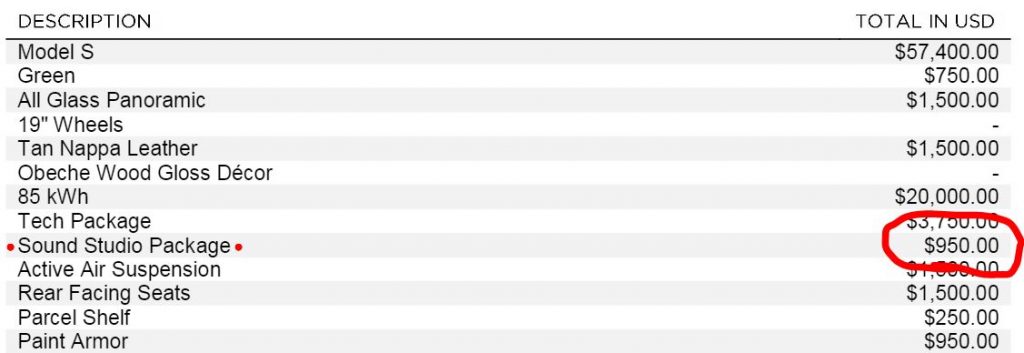
There have been several aftermarket tuners who have “stepped up to the microphone” to improve the audio systems in Teslas. Reus and NVX are probably the best known. Reus will do a near-complete rebuilding of the sound system with a price tag to match — it’s substantially more expensive than the UHFS upgrade and clearly not targeting my ears and budget. NVX offers a subwoofer kit for about $1000 that includes an additional amp but requires a lot of confident digging behind trim panels. I’d considered that a possibility but since it didn’t address the rest of the system, my concern was that it would only increase the amount of bass and make the muddiness of lower frequencies from the standard factory speakers even worse. Sure, I could pair it with an upgrade to the door speakers from someplace — but then I’m approaching the UHFS option price and buyer’s remorse would start to set in probably about the time I spilled blood or sweat installing my own upgrade.
A company called Light Harmonic (LH) had been prototyping and testing an upgrade to the UHFS when I noted that they’d expressed an interest in expanding to a plug-n-play upgrade for the standard audio. Getting the upgrades to market took some time, but as the early feedback started appearing for the UHFS upgrade (which costs $1800 and includes hand-wound speakers and a gorgeous custom amplifier that replaces the 360 watt factory one) it was clear those who waited were not disappointed– and these were customers who were ripping out their $2500 UHFS in addition to the LH system price!
For the standard audio system upgrade, LH offers a two-part upgrade. The first part hits the cash register to the tune of about $1000. It includes four custom speakers that are designed to be plug and play with the factory speakers, so you can upgrade both the front and the rear door speakers, a notable difference from the UHFS. Part 2 is still under development, but will likely end up being a direct competitor to the NVX subwoofer kit, complete with a custom amplifier and crossover. If LH could deliver on their claims of vastly improved audio for $1500 less than the factory upgrade, not only would my decision to be stingy be vindicated but the ordering math would change for many other people as well.
FedEx dropped the box on my front porch one day while I was at work. I hope the driver didn’t get a hernia. Moving into my workshop, I unpacked the contents and found the LH speakers carefully wrapped and packed into two cartons. No paperwork or installation instructions were included, but LH has a series of helpful videos on their YouTube channel that I’d already watched. Digging through the packing layers, I was nothing short of stunned when I saw the first speaker! I’d already prepped my car by removing the door panels and speakers from all the doors except for the Driver’s door, so I was quite familiar with the factory speakers by then. I couldn’t take a comparison picture fast enough — look again at these two speakers, the pictures really tell the story!
To get a better idea what LH was up to, I did a quick physical comparison of their speakers to the factory units. On the back of the speakers I noticed they reduced the ohmage in half, which effectively makes the speaker wattage double. LH has also dramatically increased the size of the magnet — it’s like comparing a stack of quarters to a hockey puck. The overall assembly of the LH speaker is superbly done with top shelf materials that make the stock speakers’ paper cones shameful. Even the plastic housing is twice as thick! I decided to weigh one of each to see what all that translated to in the end. The stock speakers are about 2/3rd of a pound. The LH speakers are… <drumroll>… over THREE AND A HALF POUNDS. That’s right, all four of the factory speakers together still weigh a pound less than ONE of the LH speakers. Those magnets are no joke.
INSTALLATION
I’m going to take a deep breath before I explain to you how easily these speakers went in. LH claimed they would be plug and play but the set I received — which I was later told was not reflective of changes made to the production run — was decidedly not cooperative. Removing the door panels was going to be the most nerve-wracking part of the install, in my mind, as I began gathering up my tools and planning my attack.
Little did I know that three out of the four LH speaker brackets would have holes so poorly aligned to the car that I’d need washers to strengthen them from the re-drilling. The worst part of it was that the first speaker was the perfect one. Plopped right in, no problems. Talk about raising hopes right before they are crushed! It was an irritating complication that I quickly worked around, but if they couldn’t place the holes accurately I don’t understand why they didn’t just make them slots. I really hope the revised brackets are more carefully matched than what I received as not every customer will be so cavalier about re-drilling their expensive new speakers.
As I mentioned before, LH has some video tutorials about how to dismantle the doors. They make things seem easy, but that’s because they’ve already loosened the clips before firing up their camera. Prying off the panels takes a pretty serious amount of pressure, carefully applied. Mostly you want to pull the clips straight off as the panels are not “hung” from the top edge like many cars. The front door panels I was able to rotate out of the way without removing them entirely, though you might want to disconnect the door lock wires as they’re the first ones stressed by that maneuver. The rear door panels really have to come off completely. BE CAREFUL when the panel is loosened and near the point of actually popping off.
There is a large panel alignment post that is sadistically located right next to the speaker and some devious engineer must have smiled when I inadvertently killed one of the factory speakers as the panel jumped off and I goofily caught it. Pulling apart the electrical connections are easy enough and labeling isn’t necessary as there are no duplicated connectors. While you have it off, you might want to go ahead and slice off an ⅛” or so of the rounded speaker surround — when I tried to reinstall my panels, the LH speakers were just enough deeper that the panel fasteners wouldn’t engage properly. Then again, maybe this has changed on the production brackets.
The factory speaker brackets are backed with a foam O-ring that keeps them from directly contacting the metal of the door. The LH brackets I received didn’t have anything to dampen their hard surface from banging or vibrating against the door frame. Concerned about them working loose and rattling, I decided to fabricate my own gaskets using a sturdy felt I pirated off my wife’s craft supplies. LH has since stated that the production versions will have a foam gasket when shipped.
The “plug” part of the installation was accurate. The Tesla audio connectors were duplicated on the LH speakers and they can only fasten one way so it’s not possible to reverse the speaker polarity, even accidentally.
Reattaching the door panels is pretty easy but there’s a lesson to be learned from the pros. Tesla’s door clips are typical automotive grade and should be good for more than one use but… I wound up with two creaky rear doors. Considering that the clips are available online for pocket-change, I recommend just replacing the whole set as you go.
STUDIO TESTING
Before I installed the entire system in the car, I wanted to gather some benchmark data. With the help of my friend Joseph St. Onge (who does have some legit audio expertise), we tested a pair of each speakers in a soundproofed production studio. We rigged up the speakers so we could switch between them and/or play them simultaneously (despite their different resistances) through a varied playlist of music, including the industry standard “Alan Parsons & Stephen Court Sound Check” both on CD and lossless to USB. The other two pairs of each speakers were installed in the Tesla itself so we could compare side to side within the car using the same USB.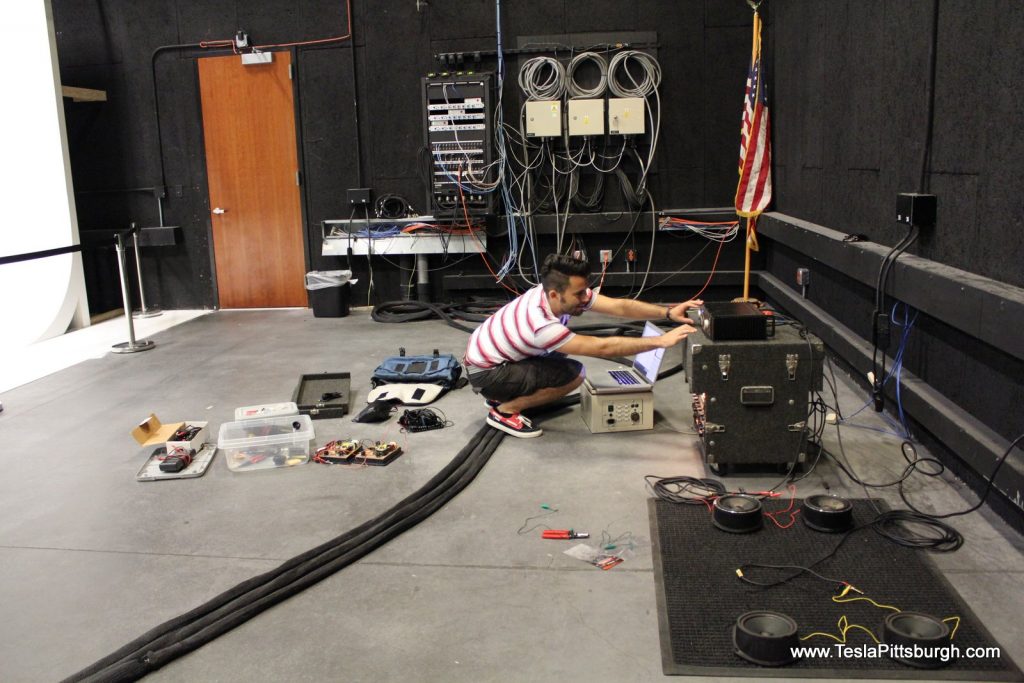
Once in the studio, we fired up the speakers and ran them through some test tones to “set the mood.” Then we started through some high quality recordings of solo instruments. The differences were immediately striking. Even without the resonance of the car doors, the speakers had very distinct voices. The factory speakers tend to do well with low volume and higher frequencies. Push them into more volume or lower frequencies and you get a lot of muddiness. The muddiness will also overtake the clarity of the upper frequencies as a proportional response to increasing volume. The LH speakers match the over bright tone of the factory speakers, but they add a depth and clarity that doesn’t disappear as lower frequencies or volume are added. In short, you can crank the music without cranking in distortion and losing the distinctness of each instrument. Closing our eyes during the instrument solos left us with the net impression with the LH speakers that the musician could possibly be in the studio with us and playing live, whereas the factory speakers never allowed us that fantasy — they sounded like a tipped over boombox was left in room.
Certain songs brought out more distinctions that we would compare later car-to-car. I’m intentionally keeping references to specific music out of this review to avoid any kind of latent bias but I will tell you that the track that first dropped our jaws was “Billie Jean” by Michael Jackson. The song has a shaker featured in the intro as a bass line walks around the keyboard. On the factory speakers the shaker dominated the wall of sound and it seemed like a good 85% of the decibels were shaker-related. Switching over to the LH speakers dropped the shaker deep into the midfield. It was still prevalent, but was mixing in with the rest of the scene at closer to 60% of the sound. Other music tracks brought out similar distinctions in the deep bass frequencies. Even when we tried to mimic the resonance of the doors using two identical boxes for each set, the effects were unchanged; the LH speakers provided more volume, more separation and reproduced the mix we got in our studio headphones more faithfully.
Back in the Tesla, we played the same track selection on each side of the car. Generally, reduced ohms results in poorer but louder sound, but even though it results in a higher quantity of sound at the same indicated volume number, the LH speakers still sound better than stock because of their improved construction. The doors’ resonance also improved the warmth of both sets of speakers but it wasn’t a net change between them. The LH set maintained their clear lead over the factory system in all but the lightest volume with the highest frequencies. Skeptical that any genre of music offered the kind of frequency range that would make the factory speakers a better choice, we agreed that would be decided by a real world test against other Teslas.
Measurements taken inside the Tesla under the same conditions backed up our impressions of higher volume. Reference tones were played through the factory speakers before the project and then again after the LH system was installed. I’ll admit I had some difficulty hearing some of the frequencies and measuring some of the others, but the results in the table were easily repeated.
HEAD TO HEAD TESTING
I finished the installation of the LH speakers and then gathered up a small fleet of comparison cars. Rather than get bogged down in stats, we did more of a focus group approach. Claus, Jake and Darren brought their cars to be guinea pigs and my friend Joseph returned to lend his professional ears. We had Claus’ standard audio car, my car with the LH speakers and Darren and Jake brought UHFS cars. My car and Jake’s were pre-Autopilot and since we weren’t sure if Tesla added more sound insulation when they changed production lines, we tried both and noted no significant difference between them and those of Claus and Darren.
For the comparison, I had each owner bring their own USBs of music that they felt would be good for the test and including some of their favorite genres and songs. That way, they’d be able to note differences between how their music normally sounded versus how it sounds in the other cars. We also had the same collection of test tones and tracks from our studio testing and as a group we covered a broad range of styles and tastes. We’d play through some selections in each car, jumping up and down the line as a group then change up tracks and repeat the process, first with the equalizers and faders at zero and later with adjustments as we deemed necessary. I’m not sure how many laps we made, but it was many and we worked through so much material that the test took about three hours — which was also a lot of fun — thanks again to my test team!
In the end, everyone ended up with some degree of satisfaction and — I hope — a set of conclusions that will be useful to everyone. It gets a little complicated, so let’s go back and point out that there are many genres of music and other audio sources/types. Some will be more limited in their tonal qualities and frequency ranges than others and depending on what your typical inputs and styles are you might have a different recommended course of action than someone else with the same car configuration but different predilections.
For listeners with an interest in higher volumes or music with more bass frequencies, the LH speakers offer a big step up. Compared to the standard speakers, we felt the LH speakers moved a lot more air and provided a lot more bass and midrange. They were also dramatically better tonally with each instrument standing out and well mixed. Claus’ car has the standard audio and he noted that “the high was a lot crisper with the LH and the bass was a little clearer.” Boosting the bass in the display’s equalizer could even approximate the thumping of a subwoofer and might be all that many need — at a price that massively undercuts the UHFS.
Joseph summarized his thoughts after our session: “My assessment is that the standard sound is good but it’s a little tinny and the mids come through a little bit but that they kinda get muddied over by the highs, so the highs and mids kind of compete with each other. And the bass comes through but it’s low, so the bass is kind of underneath everything. When we were in the LH car, the mids really come out. They’re the highest sounds that I hear. So the highs are kind of back a little bit more, mids come out — which is good in a lot of pop music, a lot of pop music pumps up the mids — and the bass comes through a lot more too. It vibrates more of the car, more of the frame. So for not extra volume, you get more bass.”
When compared against the factory speakers, the LH speakers are clearly superior. The unusual change in the sound of the “Billie Jean” shaker also repeated itself again, with the standard audio giving the hissing high frequencies too much dominance. However, if you are a talk-radio or podcast fan, the frequency response of the factory speakers will be fine. If you prefer music that is biased to higher frequencies (some classical, jazz or female vocalists in particular) and you tend to listen to them at lower volumes, the factory speakers should cover you as well. Distortion on the standard speakers is firstly and mostly noticed at higher volumes and mid to lower frequencies.
The owners of cars with UHFS were gracious about the standard speakers, but clearly felt their money was well spent — ah, but this was the showdown we were most anticipating. When compared to the LH speakers, it was generally agreed that at low to moderate volumes they were a direct competitor to the factory upgrade. In fact, the factory speakers seemed to have a thinner mix compared to the depth the LH speakers brought to the party. “Premium sound– I have to say– sounds almost just like a studio,” commented Joseph. “It sounds like the studio reference monitors that I hear all the time. So the bass comes through real punchy, real crisp.” What it lacked, we agreed, was the mid-range depth the LH speakers had.
The additional speakers in the UHFS also created a different environment in the cabin space. I’ve noted this in my loaner cars too, where my typical podcaster sounds likes he/she is sitting right in my face on the steering wheel. The sound is much more concentrated on the front of the cabin with only the rumbly low frequencies to remind you that there are actually more speakers behind you. There’s also some wackiness that goes on depending on whether or not you have the Dolby turned on. Darren noted that to compensate for this he typically fades sound way back: “…for me, with Dolby off, the rear fade is -12 for a good balance from my seat. With Dolby on, it is -6. Big HUGE difference.” We eventually attributed much of the UHFS thinness in the mids to a too-invasive Dolby setting. Once it was turned off and the equalizer adjusted, Joseph commented that the “mids come through great… the highs are crisp and those added speakers at the front really bring together the sound. The one thing that I did notice was that — like Darren had suggested — is you really want the sound more towards the back to kind of get the full spectrum of all the sound. So the premium sound you move the sound back, you get more of the full sound. On the LH and standard, you can have the sound [fader] pretty much at zero and it fills up [the cabin].” That “full-cabin/centered sound” was regarded by all to put the LH on even ground with the UHFS even though the acoustic feel was starkly different.
Just as the UHFS owners were beginning to doubt their option choices, we spun the systems up to some thumping music and ear ringing volumes and circulated through all the cars again. As the UHFS was called upon to bellow out hard rock and some of Joseph’s more rigorous tracks, the subwoofer began to deliver — and boy does it! The amount of low hertz the sub can bring to the battle just creams the LH speakers and the standard sound. The quality of the mids doesn’t improve nor is the clarity any better, but the sub just does what mere door speakers can’t. It’s the gun in a knife fight, a daisy-cutter landing right in the weak spot of the LH and standard audio’s pastures. LH will need to bring their genius minds to bear with Part 2 of the upgrade and undercut the competing subwoofer kits to win. Darren was the first to admit feeling relieved that his anticipated “buyer’s remorse” wasn’t justified… yet.
CONCLUSIONS
Of all the things to review, this has to be among the most complex. Not only are there reams of technical procedures to consider, there’s also established testing protocols that require some level of expertise to be properly executed. Even after that, it eventually could come down to any one person’s set of ears — a highly subjective and difficult to quantify measurement of “what sounds good.” I focused more on the second set of criteria because I think the data from a lab gets lost once you add in road noise and the variable quality of source material the Model S supports. I wanted to give you a real-world assessment tempered by other owners with varied interests and experience.
That brings us to a mixed conclusion. Unlike buying other add-ons, this one requires removing functional equipment — and trying to get “better” is a very different decision point than trying to get “some at all.” The LH speakers are the best door units by far, even better than the UHFS speakers in isolation. Second row passengers, in particular, benefit from the upgrade, as the UHFS doesn’t even change out the rear door speakers. If you have standard audio and are looking for “better” — THIS is it. The LH speakers are an absolute no-brainer. They are stunningly better in many — if not most — circumstances. UHFS owner Jake, who was — literally — in the driver’s seat for most of our comparison said, “I think the upgrade holds its own against the Tesla premium audio factory option!” But we all felt that the UHFS is still the best complete system overall until LH brings out their Part 2, if cost is no object.
When/if a subwoofer is added to the Light Harmonic Model S.4D upgraded standard sound, it’s hard to imagine that even the UHFS can compete — because it isn’t really that the Tesla subwoofer is so great, but rather that it exists at all compared to the absence of one — at all — in the standard audio configuration. The UHFS subwoofer just dominates the cabin. “You get the vibration but not necessarily the rattle. You get the air vibrating — it just feels good,” said Joseph after a good auditory thumping from Darren’s subwoofer. This despite the somewhat disparate acoustics from front to rear on the UHFS. There’s no question the mid-cabin sound is better with the LH, but somehow the sub just shakes the judgement right out of backseaters’ behinds, even though the $2500 upgrade is hard to justify given how steeply LH has undercut it so far.
Since you can install the LH in your own garage, their value is actually even better. While the UHFS is turnkey and pretty good, my mind stays smug knowing that the LH speakers are really the better units. My decision to forego the UHFS two years ago has been vindicated by a group of my fellow owners, squashing any concerns I had that the improvement was just a placebo effect. If you are still pondering what option to get, then seriously consider what you intend to listen to. I don’t see the UHFS being worth it in any situation when such a viable upgrade path exists aftermarket. Even if LH can’t bring their Part 2 to market in a timely manner or at a good price, the NVX option at $1000 remains open — and you’re still $500 under the factory UHFS with better sounding results and better quality gear.
That doesn’t mean everyone should ignore the UHFS as an option. If you want a turnkey system, it’s hard to argue with the factory upgrade. Especially if money is not an object or owners who are unsatisfied with their UHFS should look into the upgrade specific to their system that Light Harmonic developed before doing their standard sound upgrade. They’re using many of the same pieces and adding a strong armory of custom gear to take that system up to the next tier. Since the UHFS already includes a subwoofer, a more apples-to-apples price of the upgraded LH standard speakers in that scenario would be $2500 for UHFS with the $1800 for the LH upgrade to the UHFS — plus the costs of their recommended professional installation. You’re into your audio for a lot of coin at that point, but this would also be the very best of all possible configurations. At that price and coming full circle, the standard audio with just the Part 1 LH upgraded speakers becomes an audaciously good deal at just $1000.

